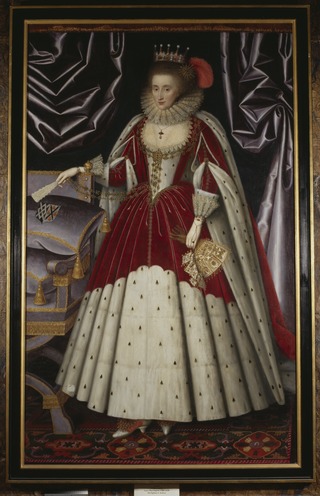Related Research Articles
Elizabeth, Lady Coke, was an English court office holder. She served as lady-in-waiting to the queen consort of England, Anne of Denmark. She was the daughter of Thomas Cecil, 1st Earl of Exeter, and Dorothy Neville, and the granddaughter of William Cecil, 1st Baron Burghley. She was the wife of Sir William Hatton and later of Sir Edward Coke.
Sir William Cornwallis was an early English essayist and served as a courtier and member of Parliament. His essays, influenced by the style of Montaigne, rather than that of Francis Bacon, became a model for later English essayists. He has sometimes been confused with his uncle of the same name.

John Harington, 1st Baron Harington of Exton in Rutland, was an English courtier and politician.
Sir James Harington of Exton was a 16th-century English public servant who fulfilled a number of legal, legislative and law enforcement duties and was knighted in 1565.

Lucy Russell, Countess of Bedford was a major aristocratic patron of the arts and literature in the Elizabethan and Jacobean eras, the primary non-royal performer in contemporary court masques, a letter-writer, and a poet. She was an adventurer (shareholder) in the Somers Isles Company, investing in Bermuda, where Harrington Sound is named after her.

Elizabeth Hastings, later Countess of Worcester was a noblewoman born in Scotland to Francis Hastings, 2nd Earl of Huntingdon, and Catherine Pole. On 16 December 1571 at Whitehall Palace in a triple wedding with Edward de Vere, 17th Earl of Oxford and bride, Anne Cecil, and Edward Sutton, 4th Baron Dudley and bride, Mary Howard, she married Sir Edward Somerset, 4th Earl of Worcester, son of Sir William Somerset, 3rd Earl of Worcester and Christian North.
Sir Francis Bodenham was an English politician who sat in the House of Commons in 1626.
Mary (Dudley) Sutton, Countess of Home (1586–1644), was a landowner, living in England and Scotland.
Bridget Markham (1579–1609), was a courtier to Anne of Denmark and subject of poems.
Theodosia Harington, Lady Dudley was an English aristocrat who was abandoned by her husband, but maintained connections at court through her extensive family networks.
Mary Middlemore was a Courtier and Maid of Honour to Anne of Denmark, subject of poems, and treasure hunter.
Sarah Harington (1565–1629) was an English courtier.
Dorothy Hastings was a courtier to Elizabeth I of England and Anne of Denmark
Mabel Harington, was a courtier to Elizabeth I of England and the sixth daughter of Sir James Harington and Lucy Harington, the daughter of Sir William Sidney of Penshurst, Kent. She married Sir Andrew Noel of Dalby and Brooke, having 7 children. Later dying in 1603.
Margaret Harington an English woman in 16th-century Spain.
Sir Richard Dyer of Staughton, was an English courtier, soldier, and landowner.

Anne Sutton was an English lady-in-waiting who was a companion of Elizabeth Stuart, Queen of Bohemia. She was the daughter of Edward Sutton, 5th Baron Dudley and Theodosia Harington. Sutton was known as "Mrs Anne Dudley" or "Mistress Dudley" although "Sutton" was the family surname. Elizabeth of Bohemia called her "Nan Duddlie".
Andrew Noel or Nowell was an English landowner and Member of Parliament.

Anne Keilway was an English aristocrat.
Elizabeth Harington was an English aristocrat.
References
- ↑ A. M. Mimardière, 'WINGFIELD, Edward (c. 1562-1603), of Kimbolton', The History of Parliament: the House of Commons 1558-1603, ed. P.W. Hasler, 1981.
- ↑ Gustav Ungerer, 'An Unrecorded Elizabethan Performance of Titus Andronicus', Shakespeare Survey, vol. 14 (Cambridge, 1961), pp. 102, 104, 108.
- ↑ William Cornwallis, Essayes (Edmund Mattes, London, 1600).
- ↑ Rebecca Shapiro, Fixing Babel: An Historical Anthology of Applied English Lexicography (Lewisburg, 2017), pp. 8, 10.
- ↑ 'Will of William Mason, Gentleman of Westminster, Middlesex', 2 February 1630, TNA PROB 11/157/110, Mason appointed as overseers of the will his "worthy friends" Sir William Bulstrode MP and Sir Edward Harington of Ridlington.
- ↑ John Maclean, Letters from George Lord Carew to Sir Thomas Roe (London, 1860), pp. 65, 132-3.
- ↑ HMC Salisbury Hatfield, vol. 19 (London, 1965), p. 83, 296.